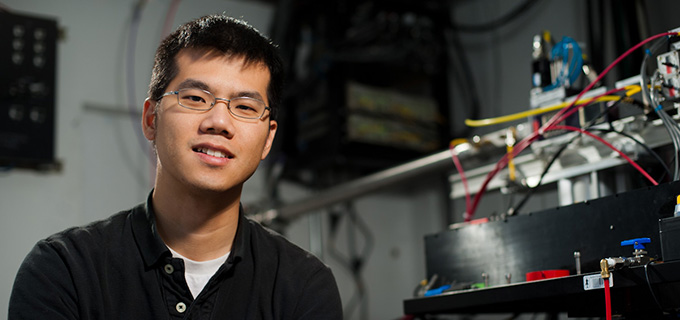
SLAC National Accelerator Laboratory and Stanford University materials science professor William Chueh has won a $5,000 Young Scientist Award from the International Society of Solid-State Ionics (ISSI).
Solid-state ionics is an emerging technology based on the movement of ions through solid materials. Advancements in solid-state ionics are improving many energy storage and conversion devices, such as batteries, fuel cells, capacitors, solar cells and chemical sensors. Compared with liquid-based energy-storage devices, solid materials tend to be more stable, less sensitive to air and can operate at higher temperatures, which increases efficiency.
Chueh received the award for his pioneering use of X-ray spectroscopy to improve electrochemical reactions central to energy-storage batteries, fuel cells and membranes that split water into separate hydrogen and oxygen molecules.

William Chueh, SLAC and Stanford materials science professor. (Matt Beardsley)
"Traditional electrochemistry experiments measure current and voltage," Chueh said. "But X-rays can reveal so much more. They are sensitive to chemical species, interfaces between materials and have fine spatial resolution. By allowing us to see deeply into materials, X-rays are opening electrochemistry to new insights and innovations."
Chueh has long been technically precocious. "My father is an electrical engineer, so I grew up with computers," he said. "I built my first one in first grade."
His family moved from Taiwan to the Los Angeles area when Chueh was 10 years old. During one high-school summer internship, he helped develop probes for fusion energy plasmas.
Chueh became hooked on electrochemistry during a senior undergraduate project on fuel cells at the California Institute of Technology. He began merging electrochemistry with X-ray spectroscopy while on a two-year surface science postdoctoral fellowship at Sandia National Laboratories in Livermore, Calif. In 2012 he joined the Stanford faculty and the Stanford Institute for Materials and Energy Sciences, a joint SLAC/Stanford Institute. Last year Chueh was named to MIT Technology Review ‘s TR35 list honoring 35 of the world's top innovators under age 35.
Chueh accepted the ISSI Young Scientist Award earlier this month at the society's 19th biennial Solid State Ionics conference, SSI-19, in Kyoto, Japan. The first SSI conference was held in Rome in 1976, and they have usually been held every other year. Stanford engineering professor (now emeritus) Robert Huggins was ISSI's first president (1988-89) and organized the 1985 conference (SSI-5) at Lake Tahoe in California. Turgut M. Gür, executive director of Stanford's Department of Energy-funded Center on Nanostructuring for Efficient Energy Conversion, organized SSI-14 (2003 in Monterey, Calif.). The ISSI was created at SSI-6 (1987) in Germany. The first ISSI Young Scientist Awards were presented two years ago.







